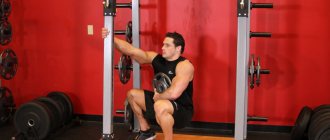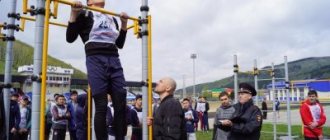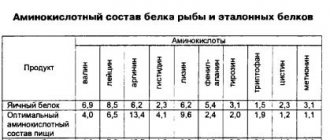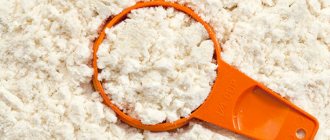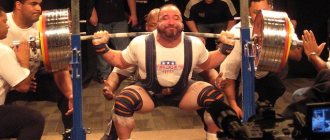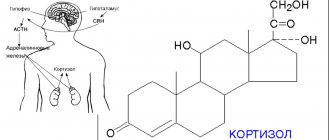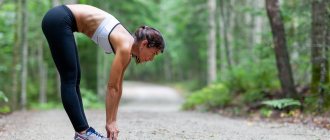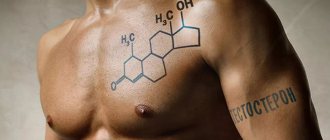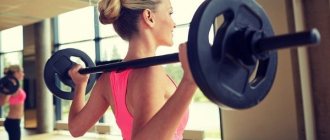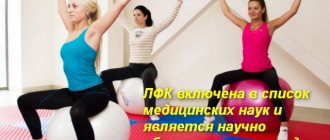Endurance test (squats)
Place your feet wider than your shoulders and, straightening your back, take a breath and sit down. We rise up as we exhale. Without stopping or resting, we do as many squats as we can. Next, write down the result and check it with the table:
- Less than 17 times is the lowest level.
- 28-35 times – average level.
- More than 41 times – high level.
Assessing the body's energy potential - Robinson index
This value demonstrates the systolic activity of the main organ - the heart. The higher this indicator is at the height of the load, the higher the functional abilities of the heart muscles. Using the Robinson index, we can (of course, indirectly) talk about myocardial oxygen consumption.
How is the test performed?
We rest for 5 minutes and determine our pulse for 1 minute in a vertical position (X1). Next, you should measure the pressure: the upper systolic value must be remembered (X2).
The Robinson index (the desired value) looks like the following formula:
IR = X1*X2/100.
We evaluate the results:
- IR equal to 69 and below - “excellent”. The working reserves of the cardiovascular system are in excellent shape.
- IR is 70-84 – good. The working reserves of the heart are normal.
- IR is 85-94 – average result. Indicates a probable insufficiency of the reserve capacity of the heart.
- IR is 95-110 – the rating is “bad”. The result indicates disturbances in the functioning of the heart.
- RI above 111 is very bad. The regulation of the heart is disrupted.
April 13, 2016
Ruffier index
We determine the reaction of the cardiovascular system. We measure our pulse for 15 seconds (1P). Next, we squat 30 times for 45 seconds (medium pace). Having finished the exercises, we immediately begin measuring the pulse - first in 15 seconds (2P) and, after 45 seconds, again in 15 seconds (3P).
The Ruffier index itself is determined by the following formula:
IR = (4*(1P+2P+3P)-200)-200/10.
We calculate the result:
- Index less than 0 – excellent.
- 0-3 – above average.
- 3-6 – satisfactory.
- 6-10 – below average.
- Above 10 – unsatisfactory.
In short, a result is considered excellent when the sum of heart beats is less than 50 for all three 15-second intervals.
What does it give
A person who has excellent self-training has good resistance to various diseases, stressful situations and the influence of other negative factors. He has well-developed respiratory and circulatory systems and metabolism. Such a person’s thinking, attention and memory are less prone to developing fatigue. All these features give a person the opportunity to achieve excellent success in educational, competitive and work practice. The maximum level of physical fitness is acquired through the endurance and diligence of students.
Response of the autonomic nervous system to physical activity - orthostatic test
The test is carried out as follows:
In the morning (before exercise) or after 15 minutes (before eating), spent in a calm state and in a horizontal position, we measure the pulse in a horizontal position. We count the pulse for 1 minute. Then we get up and rest in an upright position. Again, count the pulse for 1 minute in a vertical position. The difference in the obtained values indicates the reaction of the heart to physical activity subject to a change in body position, thanks to which one can judge the fitness of the body and the “working” state of regulatory mechanisms.
Results:
- A difference of 0-10 strokes is a good result.
- A difference of 13-18 beats is an indicator of a healthy, untrained person. Rating: satisfactory.
- A difference of 18-25 strokes is unsatisfactory. Lack of physical fitness.
- Above 25 beats is a sign of overwork or some illness.
If the average difference in shocks is 8-10 for you, then the body is able to recover quickly. With an increased difference, for example, up to 20 beats, it’s worth thinking about where you are overloading the body.
Indicators of physical fitness (physical qualities of a person)
If we don’t talk about health problems, an athlete can achieve physical fitness only by diligently performing a variety of exercises. Preparation reflects the processes of growth and formation at individual stages of individual ontogenesis (development). The nuances of ngo directly depend on the personal characteristics of its design and body structure.
Physical fitness is an extremely important indicator of the general condition and level of health of the population of a particular country. It is usually put on a par with mortality, fertility or morbidity.
general information
Some processes are constantly taking place in the body of each of us; they do not stop until our life cycle ends. They are usually divided into age stages, which are characterized by their properties (mental, physical, morphological, functional). The higher the level and speed of the totality of these processes, the more physically prepared a person can be considered, and his nervous, mental, and physical performance is high.
Sometimes, due to the fact that the sequence of development is disrupted in the early stages of intrauterine development, irreversible changes occur that affect the entire vital activity of the body. However, in most cases, if we don’t talk about pathologies, external factors have a direct impact on a person’s physical fitness: upbringing, dietary habits, social nuances, and the presence of diseases. They are more significant than genetic inclinations and can have an impact many times more powerful.
But what is physical fitness, what properties can be included in the list of properties of any organism? Indicators of physical fitness include functions that are assessed on the basis of simple data: height, body weight, proportions of development of its individual parts, lung capacity, muscle strength, tone, condition of the musculoskeletal system, posture, presence, thickness of the lipid layer and much more. more. It so happened that it is customary to evaluate the general condition based on external morphological factors, but only in conjunction with functional parameters, for the objectivity of the assessment.
Strength or muscle strength
This indicator is expressed in a person's ability or inability to withstand a certain level of resistance by tensing the muscles. Many activities involve the development of such strength both in everyday life and in production. In many ways, this factor depends not only on the mass and quality of the muscles themselves, but also on the biochemical processes that occur in them, as well as the activity of the central nervous system. It can occur in isotonic or isometric mode. In the first case, this refers to dynamic (explosive) force (contraction or stretching of muscles), and in the second to static force (maintaining one position under load). There are several types of force.
- Muscular . This is the ability of the muscle to overcome any resistance.
- Absolute . This term refers to the degree of force tension while overcoming resistance, without taking into account the total mass.
- Relative . This is the ratio of force per unit of own weight.
- Express . To measure such strength, you can be guided by such indicators as the strength of the arms, legs, abdominals, and back.
Increased strength is directly related to increased muscle mass. Moreover, this has both an aesthetic aspect (body beauty) and a purely “applied” aspect - strong muscles are less susceptible to injury, they help maintain natural body weight. Muscles require much more calories than lipid layers, which is why strong people are usually less susceptible to problems such as abdominal or constitutional exogenous obesity.
Quickness (speed)
This property is directly characterized by how often muscles can contract and relax. The concept is divided into three main subcategories.
- Sprint speed.
- Speed of movement.
- Fast response.
The easiest way to determine sprint speed. It is calculated simply: you need to measure how long it takes an athlete to run a distance of twenty-five meters.
Endurance
This indicator of physical fitness is a rather broad concept. It covers all the qualities that indicate how long the body can withstand various stresses.
- General or aerobic . To convert sugar (carbohydrates) into clean energy, the aerobic system uses oxygen. With intense exercise, the process can affect lipids and even proteins (catabolism). Working to the limit of your aerobic endurance helps you burn more excess mass. Measurements for this property are usually carried out during a run of 2 kilometers for girls, 3 kilometers for boys.
- Sprint (speed) . This is the ability to withstand loads at the highest rates of muscle contraction and relaxation. Usually measurements are also taken while running per unit of time.
- Power . This is the ability to withstand quite significant force loads. This quality is determined by how long the muscles are capable of repeating the same efforts over a certain period of time. It is defined differently for different muscle groups: shoulder girdle - hanging pull-ups, abdominals - raising and lowering the body while lying down.
- Speed-strength . This indicator combines the last two. It highlights the ability to perform any strength exercise or work for a specific period of time.
Flexibility
One of the most important qualities is characterized by the ability of the human body to perform various movements with a relatively large amplitude and scope. The maximum of this value will be considered flexibility. It denotes the general mobility of all joints of the body. Experts distinguish two main forms of mobility.
- Passive . These are those that are made under the influence of external factors and forces.
- Active . Voluntary movements that are performed by contracting and relaxing muscle groups passing through a particular joint.
If an athlete’s training complex includes only strength loads, and not enough attention is paid to stretching, the flexibility indicator can drop significantly, even with regular exercise. Physical fitness is also characterized by this important property.
Dexterity
This is a quality that helps to learn different movements in a minimum period of time. This also takes into account the ability to quickly adjust and “adapt” to performing such movements. The outstanding Soviet scientist-physiologist Nikolai Aleksandrovich Bernstein considered this property to be the ability to quickly and with the least resistance motorically get out of any difficult situation.
From a psychological point of view, dexterity can directly depend on the quality of the central nervous system, the ability to adequately evaluate and solve various motor problems. The greater the set of motor skills, the higher the agility score. People who have such abilities are more pronounced can easily learn to juggle, play different games, and perform acrobatic exercises.
Composition and coordination
Another important quality, it determines the ratio in one organism of the presence of lipid, protein, and bone tissue. Depending on weight, age, you can determine the degree of health and physical fitness. It is clear that excess fat mass can indicate heart disease, hypertension, diabetes and other problems.
Coordination is directly related to agility as well as body composition. This is the ability to properly control one’s own muscles, demonstrating the coherence of the work of different body systems. Good coordination of movements allows you to maintain balance and not get tired longer due to the precision of performing various body movements.
Proportionality
This property is also called the height-weight indicator, and its essence lies in the name itself. This is a set of parameters, which include body weight, height, distribution of weight centers, body type. This guides professional trainers when selecting a particular person to perform certain exercises or engage in different sports, depending on the individual characteristics of the body.
Functional status check
To begin with, Irina Valentinovna explained that using the phrase “physical state” is incorrect: “There are the concepts of “physical development” and “functional state.” Physical development is the correspondence of anthropometric data and a number of other parameters to the average values of groups of people divided by age and gender.”
If we talk about assessing the functional state, which determines the ability to tolerate physical activity, then to determine it, many tests are used that evaluate the response to physical activity of all interested body systems. Such systems include the cardiovascular system, central, peripheral and autonomic nervous systems, endocrine system, and so on.
Tests to determine the functional state of most systems are complex and cannot be used in everyday life.
By developing a theory about the unity of processes occurring in the body, which says that changes in one of the body systems will sooner or later lead to changes in other systems, it is possible, by conducting simple tests, to assess the state of the system that is most accessible for obtaining indicators. Such systems are the cardiovascular system and the autonomic nervous system; their response to stress can be assessed using heart rate.
Requirements for the level of physical fitness of military personnel
Testing the level of physical fitness is prescribed in the army for a reason. Much depends on the length of service, type of military service and rank. People associated with military service are tested for strength, endurance and speed, especially in hand-to-hand combat. Contract employees must:
- overcome 100 meters in fifteen seconds;
- run a cross-country race – 3 km in fourteen minutes;
- pull up 10 times;
- do push-ups from the floor forty-five times.
How to determine the level of physical fitness of officers? Their standards are slightly different. Officers need:
- do push-ups thirty times;
- run a three-kilometer cross-country race in fifteen minutes;
- run one hundred meters in sixteen seconds;
- do eight pull-ups.
This way you can determine the level of physical fitness of military personnel. Such stringent requirements are necessary to maintain a high level of combat effectiveness in the army.
Power loads
Another exercise is given to test the level of physical fitness. Let's try push-ups from the floor. This exercise must be done correctly, with a straight back. As for women, they are allowed to rise from their knees.
Now let's check the results:
Men
| Grade | Age | ||
| 18-29 | 30-39 | 40+ | |
| good | 30 and more | 25 and more | 21 and older |
| Average | from 17 to 29 | 13-24 | 10-20 |
| Bad | less than 17 | less than 13 | less than 10 |
Women
| Grade | Age | ||
| 18-29 | 30-39 | 40+ | |
| good | 15 and more | 13 and more | 11 and more |
| Average | from 10 to 14 | 8-12 | 5-10 |
| Bad | less than 10 | less than 8 | less than 5 |
You can also make a plank. This test of your fitness level will show how deep your core muscles are and how developed your abs are.
- We stretch the body from the top of the head to the heels.
- We bend our arms at the elbows.
- We lock the hands together.
- You need to hold out as long as you have enough strength.
Results are considered good if a person holds the bar for more than ninety seconds, average - 60-90, but bad - less than sixty.
How to choose fitness tests for yourself?
First, clearly define the parameters you want to work with in training. You need to select tests that correspond to the parameter being tested.
Development of flexibility
If you are working on flexibility, use and also check. The last test is useful for everyone to do to avoid troubles with the lower back.
general physical preparation
If you are engaged in general physical training and health activities, regularly do, or. They will tell you when to pay attention to cardio training.
Regularly test yourself in test exercises: squats for reps, reps, squats with a barbell, pull-ups, long jumps, running a certain distance, etc. If the results are growing, then everything is in order. If they decrease or do not change, it is worth taking measures to improve the training program or just take a few days off.
Weight loss
If you are working on weight loss, regularly perform the Ruffier-Dixon test, weigh yourself (no more than once a week), take body measurements (once a month).
Test formula: RDI = (4 x (P1 + P2 + P3) – 200) / 10
Strength development, powerlifting
If you train for strength, regularly test your capabilities in the most important strength exercises:,. Progress is clearly visible if you keep regular training records. The increase in working weights and the number of repetitions with them speaks for itself.
Don't forget to test yourself with the Ruffier-Dixon test. It will show the condition of the heart. If the indicators get worse, you need to pay attention to cardio training.
Bodybuilding and muscle gain
Bodybuilding and gaining muscle mass involve regular weighing and girth measurements of all areas of the body. Pay special attention to your waist circumference. If it grows noticeably, then you need to pay attention to your nutrition (you are gaining extra pounds that have nothing to do with muscles). Also get a Ruffier-Dixon or Cooper test regularly to monitor your heart health.
Choose the fitness test that suits you and do it regularly every 2-4 weeks at the same time of day. Compare the results and draw conclusions.
Any questions you may have can be asked through the comment form under the articles.
For training to be enjoyable and beneficial, you must be able to do it. We offer fitness tests that will help determine whether you have enough flexibility, strength and endurance, how strong your muscles are and how your heart reacts to stress.
How to create an individual training program
Using these tests, you can independently determine your physical fitness and create an exercise program.
When determining physical fitness, a calculator is used, and when drawing up an individual training program, an adder and dispenser are used.
Fitness calculator
is intended for a comprehensive assessment of the functional capabilities of the cardiovascular system and physical fitness using the CONTREX-2 scoring system (control-express).
The CONTREX-2 system was developed by domestic scientists S.A. Dushanin, E.A. Pirogova and L.Ya. Ivashchenko (1984), they created several diagnostic systems for primary (CONTREX-3), current (CONTREX-2) and self-monitoring (CONTREX-1).
Indicators for determining the level of physical condition according to the CONTREX-2 system are given below.
CONTREX-2 includes 11 indicators and tests, which are assessed as follows:
1. Age.
Each year of life gives 1 point. For example, at age 50, 50 points are awarded, etc.
2. Body weight.
Normal weight is estimated at 30 points. For each kilogram in excess of the norm, calculated using the following formulas, 5 points are deducted:
men: 50 + (height – 150)x0.75 + (age – 21)/4
women: 50 + (height – 150)x0.32 + (age – 21)/5
For example, a 50-year-old man with a height of 180 cm has a body weight of 85 kg, and normal body weight will be:
50 + (180 – 150) x 0.75 + (50 – 21)/4 = 80 kg.
For exceeding the age norm by 5 kg, 5 × 5 = 25 points are deducted from the total points.
3. Blood pressure.
Normal blood pressure is estimated at 30 points. For every 5 mm Hg. Art. systolic or diastolic pressure above the calculated values, determined by the formula below, 5 points are subtracted from the total amount:
men: ADsyst. = 109 + 0.5 x age + 0.1 x body weight; ADdiast. = 74 + 0.1 x age + 0.15 x body weight;
women: ADsyst. = 102 + 0.7 x age + 0.15 x body weight; ADdiast. = 78 + 0.17 x age + 0.1 x body weight.
For example, a 50-year-old man weighing 85 kg has a blood pressure of 150/90 mmHg. Art.
The age norm for systolic pressure is:
109 + 0.5 x 50 + 0.1 x 85 = 142.5 mmHg. Art.
Normal diastolic pressure:
74 + 0.1 x 50 + 0.15 x 85 = 92 mm Hg. Art.
For exceeding the norm of systolic pressure by 7 mm Hg. Art. 5 points are deducted from the total.
4. Pulse at rest.
For each hit less than 90, one point is awarded. For example, a heart rate of 70 per minute gives 20 points. If the pulse is 90 or higher, no points are awarded.
5. Flexibility.
Standing on a step with your knees straight, bend forward, touching the mark below or above the zero point (it is at the level of your feet) and maintaining the pose for at least 2 seconds. Each centimeter below the zero point is equal to or exceeds the age norm given for men and women in the table. 1, is estimated at 1 point; if the standard is not met, no points are awarded. The test is carried out three times in a row, and the best result is counted.
For example, a 50-year-old man, when bending over, touched a mark of 8 cm below the zero mark with his fingers. According to table. 1, the standard for a 50-year-old man is 6 cm. Therefore, 1 point is awarded for meeting the standard and 2 points for exceeding it. The total is 3 points.
Table 1. Motor test standards for assessing basic physical qualities
| Age, years | Flexibility, cm | Speed, cm | Dynamic force, cm | Speed endurance | Speed-strength endurance | General Stamina | ||||||||
| 10-minute run, m | 2000 m, min. | |||||||||||||
| husband. | wives | husband. | wives | husband. | wives | husband. | wives | husband. | wives | husband. | wives | husband. | wives | |
| 19 | 9 | 10 | 13 | 15 | 57 | 41 | 18 | 15 | 23 | 21 | 3000 | 2065 | 7,00 | 8,43 |
| 20 | 9 | 10 | 13 | 15 | 56 | 40 | 18 | 15 | 22 | 20 | 2900 | 2010 | 7,10 | 8,56 |
| 21 | 9 | 10 | 14 | 16 | 55 | 39 | 17 | 14 | 22 | 20 | 2800 | 1960 | 7,20 | 9,10 |
| 22 | 9 | 10 | 14 | 16 | 53 | 38 | 17 | 14 | 21 | 19 | 2750 | 1920 | 7,30 | 9,23 |
| 23 | 8 | 9 | 14 | 16 | 52 | 37 | 17 | 14 | 21 | 19 | 2700 | 1875 | 7,40 | 9,36 |
| 24 | 8 | 9 | 15 | 17 | 51 | 37 | 16 | 13 | 20 | 18 | 2650 | 1840 | 7,50 | 9,48 |
| 25 | 8 | 9 | 15 | 17 | 50 | 36 | 16 | 13 | 20 | 18 | 2600 | 1800 | 8,00 | 10,00 |
| 26 | 8 | 9 | 15 | 18 | 49 | 35 | 16 | 13 | 20 | 18 | 2550 | 1765 | 8,10 | 10,12 |
| 27 | 8 | 9 | 16 | 18 | 48 | 35 | 15 | 12 | 19 | 17 | 2500 | 1730 | 8,20 | 10,24 |
| 28 | 8 | 8 | 16 | 18 | 47 | 34 | 15 | 12 | 19 | 17 | 2450 | 1700 | 8,27 | 10,35 |
| 29 | 7 | 8 | 16 | 18 | 46 | 33 | 15 | 12 | 19 | 17 | 2400 | 1670 | 8,37 | 10,47 |
| 30 | 7 | 8 | 16 | 19 | 46 | 33 | 15 | 12 | 18 | 16 | 2370 | 1640 | 8,46 | 10,58 |
| 31 | 7 | 8 | 17 | 19 | 45 | 32 | 14 | 12 | 18 | 16 | 2350 | 1620 | 8,55 | 11,08 |
| 32 | 7 | 8 | 17 | 19 | 44 | 32 | 14 | 11 | 18 | 16 | 2300 | 1590 | 9,04 | 11,20 |
| 33 | 7 | 8 | 17 | 20 | 43 | 31 | 14 | 11 | 17 | 16 | 2250 | 1565 | 9,12 | 11,30 |
| 34 | 7 | 8 | 17 | 20 | 43 | 31 | 14 | 11 | 17 | 15 | 2220 | 1545 | 9,20 | 11,40 |
| 35 | 7 | 8 | 18 | 20 | 42 | 30 | 14 | 11 | 17 | 15 | 2200 | 1520 | 9,28 | 11,50 |
| 36 | 7 | 7 | 16 | 20 | 42 | 30 | 13 | 11 | 17 | 15 | 2200 | 1500 | 9,36 | 12,00 |
| 37 | 7 | 7 | 18 | 21 | 41 | 29 | 13 | 11 | 16 | 15 | 2100 | 1475 | 9,47 | 12,12 |
| 38 | 6 | 7 | 18 | 21 | 41 | 29 | 13 | 11 | 16 | 15 | 2100 | 1460 | 9,52 | 12,20 |
| 39 | 6 | 7 | 19 | 21 | 40 | 29 | 13 | 10 | 16 | 14 | 2000 | 1445 | 10,00 | 12,30 |
| 40 | 6 | 7 | 19 | 22 | 39 | 28 | 13 | 10 | 15 | 14 | 2000 | 1420 | 10,08 | 12,40 |
| 41 | 6 | 7 | 19 | 22 | 39 | 28 | 13 | 10 | 15 | 14 | 2000 | 1405 | 10,14 | 12,48 |
| 42 | 6 | 7 | 19 | 22 | 39 | 28 | 12 | 10 | 15 | 14 | 2000 | 1390 | 10,22 | 12,58 |
| 43 | 6 | 7 | 20 | 22 | 38 | 27 | 12 | 10 | 15 | 14 | 2000 | 1370 | 10,30 | 13,07 |
| 44 | 6 | 7 | 20 | 23 | 38 | 27 | 12 | 10 | 15 | 14 | 1950 | 1355 | 10,37 | 13,16 |
| 45 | 6 | 7 | 20 | 23 | 37 | 27 | 12 | 10 | 15 | 13 | 1950 | 1340 | 10,44 | 13,25 |
| 46 | 6 | 7 | 20 | 23 | 37 | 27 | 12 | 10 | 15 | 13 | 1900 | 1325 | 10,52 | 13,34 |
| 47 | 6 | 7 | 20 | 23 | 36 | 26 | 12 | 9 | 15 | 13 | 1900 | 1310 | 10,58 | 13,43 |
| 48 | 6 | 6 | 21 | 24 | 36 | 26 | 12 | 9 | 14 | 13 | 1900 | 1300 | 11,05 | 13,52 |
| 49 | 6 | 6 | 21 | 24 | 36 | 26 | 11 | 9 | 14 | 13 | 1850 | 1285 | 11,12 | 14,00 |
| 50 | 6 | 6 | 21 | 24 | 35 | 25 | 11 | 9 | 14 | 13 | 1850 | 1273 | 11,19 | 14,08 |
| 51 | 6 | 6 | 21 | 24 | 35 | 25 | 11 | 9 | 14 | 13 | 1800 | 1260 | 11,25 | 14,17 |
| 52 | 6 | 6 | 22 | 25 | 35 | 25 | 11 | 9 | 14 | 12 | 1800 | 1250 | 11,34 | 14,25 |
| 53 | 5 | 6 | 22 | 25 | 34 | 25 | 11 | 9 | 14 | 12 | 1800 | 1235 | 11,40 | 14,34 |
| 54 | 5 | 6 | 22 | 25 | 34 | 24 | 10 | 9 | 14 | 12 | 1750 | 1225 | 11,46 | 14,42 |
| 55 | 5 | 6 | 22 | 25 | 34 | 24 | 10 | 9 | 13 | 12 | 1750 | 1215 | 11,54 | 14,50 |
| 56 | 5 | 6 | 22 | 25 | 33 | 24 | 10 | 9 | 13 | 12 | 1750 | 1200 | 12,00 | 14,58 |
| 57 | 5 | 6 | 23 | 26 | 33 | 24 | 10 | 9 | 13 | 12 | 1700 | 1190 | 12,05 | 15,06 |
| 58 | 5 | 6 | 23 | 26 | 33 | 24 | 10 | 9 | 13 | 12 | 1700 | 1180 | 12,11 | 15,14 |
| 59 | 5 | 6 | 23 | 26 | 33 | 23 | 10 | 8 | 13 | 12 | 1700 | 1170 | 12,17 | 15,20 |
| 60 | 5 | 6 | 23 | 26 | 32 | 23 | 10 | 8 | 13 | 12 | 1650 | 1160 | 12,24 | 15,30 |
6. Speed.
It is assessed by a “relay” test based on the speed at which the strongest hand squeezes a falling ruler. For each centimeter equal to the age norm or less, 2 points are awarded.
The test is performed in a standing position.
The strongest hand with straightened fingers (palm edge down) is extended forward. The assistant takes a 50-centimeter ruler and sets it vertically (the number “zero” faces the floor). In this case, your hand is approximately 10 cm below the end of the ruler.
After the “attention” command, the assistant must release the ruler within 5 seconds. The examinee's task is to grab the ruler as quickly as possible with his thumb and forefinger. The distance in centimeters is measured from the bottom edge of the palm to the zero mark of the ruler.
The test is carried out three times in a row, the best result is counted.
For example, for a 50-year-old man, the test result was 17 cm, which is 4 cm better than the age standard. There are 2 points for meeting the norm and 4x2 = 8 points for exceeding it. The total amount is 10 points.
7. Dynamic force
(Abalakov’s test). Estimated by the maximum height of a standing jump. For each centimeter equal to or exceeding the standard value given in table. 1, 2 points are awarded.
Running the test:
the subject stands sideways to the wall next to a vertically mounted measuring scale (student's ruler 1 m long). Without lifting his heels from the floor, he touches the scale as high as possible with his more active hand raised up. Then he moves away from the wall at a distance of 15 to 30 cm, without taking a step, jumps up, pushing off with both legs. With his more active hand, he touches the measuring scale as high as possible. The difference between the values of the first and second touch characterizes the height of the jump. Three attempts are given, the best one counts.
For example, a 50-year-old man has a result of 40 cm. This exceeds the age norm by 5 cm (see Table 1). For fulfilling the standard, 2 points are awarded, for exceeding - 5 × 2 = 10 points. The total is 10+2 = 12 points.
8. Speed endurance.
The maximum frequency of raising straight legs to an angle of 90° from a supine position is calculated in 20 seconds. For each lift equal to or exceeding the standard value, 3 points are awarded.
For example, for a 50-year-old man, the test result was 15 lifts, which exceeds the age norm by 4. For fulfilling the standard, 3 points are awarded, for exceeding 4 × 3 = 12 points. Total 15 points.
9. Speed-strength endurance.
The maximum frequency of bending the arms in a lying position (women in a kneeling position) is measured in 30 seconds with 4 points awarded for each bending equal to or exceeding the standard.
For example, when testing a 50-year-old man, the frequency of bending his arms in support in 30 s was 18 times. This exceeds the age standard by 4 and gives 4×4 = 16 points, plus 4 points for meeting the standard value. The total is 20 points.
10. General endurance.
1) Persons who have not previously exercised
or who have been practicing for no more than 6 weeks, can use the following indirect method.
Performing endurance exercises five times (running, swimming, cycling, rowing, skiing or skating) for 15 minutes at a heart rate of at least 170 per minute minus age in years (the maximum allowable heart rate is 185 minus age) - gives 30 points, 4 times a week – 25 points, 3 times a week – 20 points, 2 times – 10 points, 1 time – 5 points, not a single time and if the rules described above regarding heart rate and training aids are not followed – 0 points.
No points are awarded for performing morning exercises.
general endurance is assessed based on the result of a 10-minute run over the greatest possible distance. For fulfilling the standard given in table. 2, 30 points are awarded and for every 50 m of distance exceeding this value, 15 points. For every 50 m of distance less than the age standard, 5 is subtracted from 30 points. The minimum number of points scored for this test is 0. The test is recommended for individuals who independently engage in physical exercise.
3) For group classes
the level of development of general endurance is assessed using races of 2000 m for men and 1700 m for women. The control is the standard time given in table. 1. For compliance with the regulatory requirement, 30 points are awarded and for every 10 seconds less than this value - 15 points. For every 10 seconds more than the age standard, 5 points are subtracted from 30 points. The minimum number of points for the test is 0.
For example, for a 50-year-old man, the result of a 10-minute run will be 1170 m, which is 103 m less than the age standard. Therefore, the sum of points for this test will be 30–10 = 20 points.
11. Pulse recovery.
1) For those who do not exercise
after 5 minutes of rest in a sitting position, take your pulse for 1 minute, then do 20 deep squats for 40 seconds and sit down again. After 2 minutes, measure the pulse again for 10 seconds and multiply the result by 6. Compliance with the initial value (before the load) gives 30 points, exceeding the pulse by 10 beats - 20 points, by 15 - 10 points, by 20 - 5 points, more than 20 beats – 10 points should be subtracted from the total.
2) Those who exercise for more than 6 weeks
Heart rate recovery is assessed 10 minutes after the end of a 10-minute run or a 2000 m run for men and 1700 m for women by comparing the post-run heart rate with the initial value. Their coincidence gives 30 points, exceeding up to 10 hits - 20 points, 15 - 10 points, 20 - 5 points, more than 20 hits - 10 points should be subtracted from the total amount.
For example, a 50-year-old man’s heart rate before running was 70 per minute, 10 minutes after a 10-minute run it was 72, which practically coincides with the initial heart rate and this provides 30 points.
results
After summing up the points obtained for all 11 indicators, the physical condition is assessed as:
– low
– less than 50 points;
– below average
– 51–90 points;
– average
– 91–160 points;
– above average
– 160–250 points;
– high
– more than 250 points.
published
There are quite a number of scientifically based fitness tests to check your condition. Fitness tests are needed to determine the most important parameters of your body:
1. Level of development of the cardiovascular system. 2. Level of flexibility in certain areas of the body. 3. Condition of the spine (most important curves). 4. The level of strength and endurance in certain (the most important for you) exercises: push-ups, squats, strength exercises with weights, running certain distances against time.

